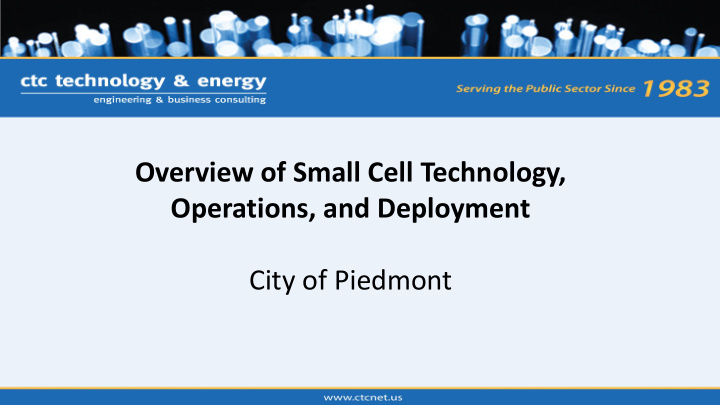



Overview of Small Cell Technology, Operations, and Deployment City of Piedmont
Presentation 1. Overview of Wireless Structures 2. 3G/4G Macro Cell Deployment 3. Enhancing Macro Site Performance 4. Small Cells: What They Are, How They Operate 5. Small Cell Deployment Options 6. Radio Frequency (RF) Energy Exposure 7. 5G: Potential Future Technologies
3 Traditional Macro Towers and Monopoles Self-Supporting Lattice Tower Monopole with Equipment
3G/4G: Existing Macro Tower Infrastructure 3 – Sector Antennas 100 – 150 ‘ AGL 700Mhz – 4G
Macro Tower Multi-Band Capacity Enhancement For Broadband Wireless 3 – Sector Antennas 100 – 150 ‘ AGL 700Mhz – 4G Focused Existing Macro Tower Infrastructure • Additional Wireless Bands • Increased Data Throughput Capacity Near Tower Site • Often Additional Sector Antennas within a Wireless Band
Macro Towers Plus Small Cells: Enhancing Broadband Capacity and In-Building Coverage 3 – Sector Antennas 100 – 150 ‘ AGL 700Mhz – 4G Small Cells Antenna 15 - 30’ AGL Spaced 700- 1500’ Focused Existing Macro Tower Infrastructure
Ongoing Upgrades to LTE Technology: Enhancing Macro Tower Coverage and Data Throughput • Increasing data speeds with the addition of 256 QAM symbol encoding • Expanding the number of antenna sectors (expanded spectrum reuse) • MIMO antennas (multiple polarization, i.e. horizonal, vertical ++) • Dynamic “smart” beam - forming antennas • Enhanced co-channel interference rejection decoding algorithms • Smarter signal detection algorithms device transmitting power control • Enhanced narrow band voice encoding techniques reduce network VoLTE traffic
Improved in-Building Coverage Affordable Wireless Signal Boosters • External antenna receives wireless signal and provides satisfactory in-building LTE performance (similar to outside TV antenna) • Internal amplifier (or signal re-generating equipment) provides higher signal within the building • FCC released WT Docket No. 10-4 on March 23, 2018 to permit manufacture of affordable, reliable, low-cost, in-building signal amplification equipment installable by homeowners
9 Small Cell System Deployment Overview
10 First-Generation Small Cell Antenna Systems More Obtrusive Design Less Obtrusive Design
Configuration Options (Utility Pole Communications Space)
Configuration Options (Stop Sign)
Configuration Options (Street Light)
Major Planning Challenge in Residential Communities • Augmenting tower and rooftop cells with small cells in ROW • 200,000 cell towers nationally today; millions of small cells coming • New cells will be placed near users in buildings, residential neighborhoods and public ROWs • Additional fiber optic cable will be required in neighborhoods to backhaul wireless access points • 5-10 year lifecycle of wireless equipment is much shorter than that of fiber or mounting structures
15 Federal RF Exposure Guideline Standards • National Environmental Policy Act of 1969 (NEPA) requires the Federal Government to evaluate and set standards • FCC has been assigned the responsibility to set standards for human exposure to RF energy emitted by FCC-regulated equipment • FCC adopted first set of guidelines in 1985 • Current FCC guidelines: OET Bulletin 65 Edition 97-01 • GAO requested in July 2012 (GAO-12-771) that FCC re-examine radiation impact of closely held cell phones • Every community has some degree of concern about radiation
16 How Were the Standards Derived? • Experts and Standards Bodies: – National Council on Radiation Protection and Measurement – Institute of Electrical and Electronic Engineers (IEEE) – American National Standards Institute (ANSI) • Comments to the FCC During Rule-Making: – Environmental Protection Agency (EPA) – Food ands Drug Administration (FDA) – Federal safety and health agencies – Others
17 Federal RF Exposure Guideline Standards Source FCC
18 Federal RF Exposure Guideline Standards Typical Power Levels of Common RF Devices Nearby Sites Local Equipment TV/FM Towers – 1 MW Microwave 1KW Macro Cell-5 KW WIFI Devices 1W Small Cell – 1KW Smartphone 0.5W Public Safety-1KW Bluetooth devices 5mW
19 Federal RF Exposure Guideline Standards Source FCC R&R
5G Technology • Under development (standards in 2018, possibly wide-scale in 2020) • Requires much more fiber; business case still emerging • Goals are high bandwidth (1 Gbps per user) and low latency (10 ms and down to 1 ms for critical machine-to-machine) • To support migration of most consumer and business applications to wireless, including machine-to-machine such as IoT, autonomous vehicles • One site can flexibly serve many wireless providers through “slicing” • Capacity on demand; less processing at site • Architecture and business model widely varying based on local needs • Fiber backhaul augmented by wireless • Tiered topology (sometimes mesh)
Emerging 5G Architecture • Millimeter wave spectrum requires direct or near line of sight – Radios every two poles and/or equivalent on rooftops – Foliage a huge issue – Indoor and outdoor radios – Widespread fiber
Industry Players • Network Operators/Carriers – AT&T Mobility, Verizon Wireless, T-Mobile, Sprint • Tower/Wireless Infrastructure Companies – Crown Castle, Mobilitie, Extenet • Backhaul Providers – Crown Castle, Zayo, cable companies, ILECs • Manufacturers – AirSpan, Ericsson, Motorola, Nokia • Regional Turf Contractors – Black & Veatch, Bechtel • Engineering/Construction – Henkels & McCoy, MasTec
Recommend
More recommend